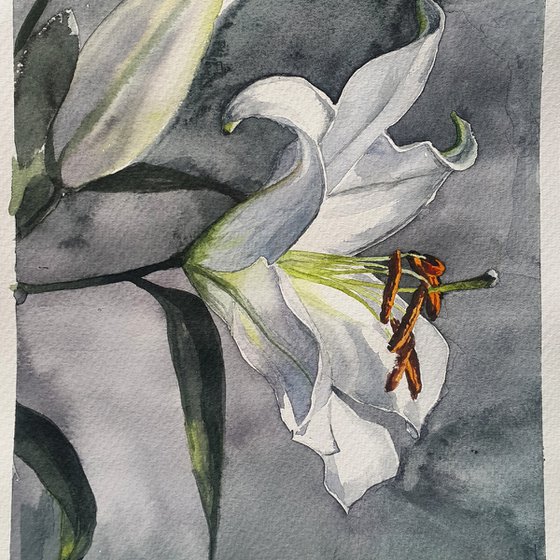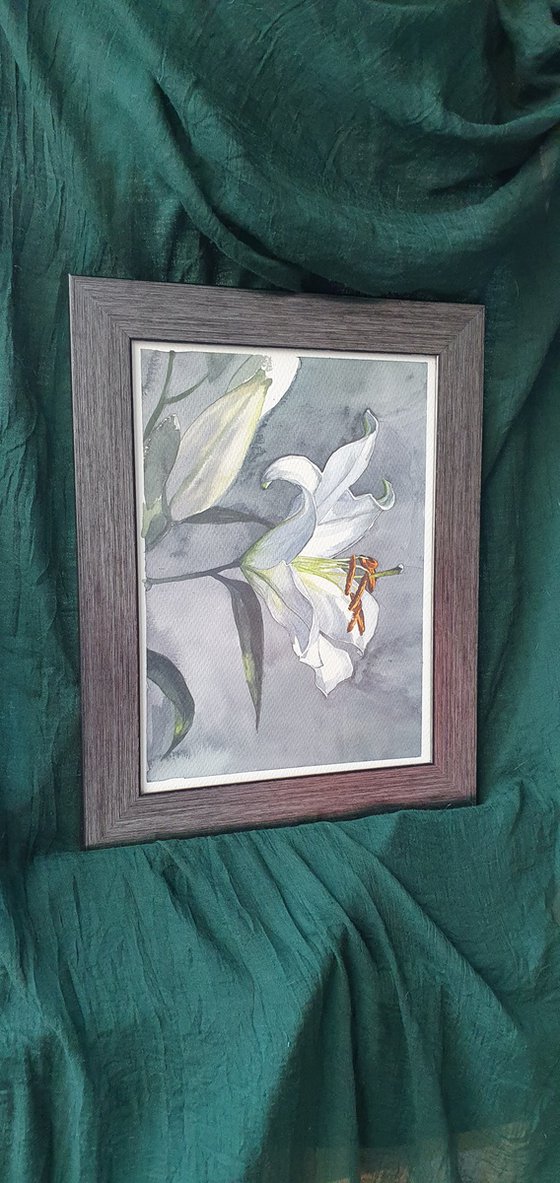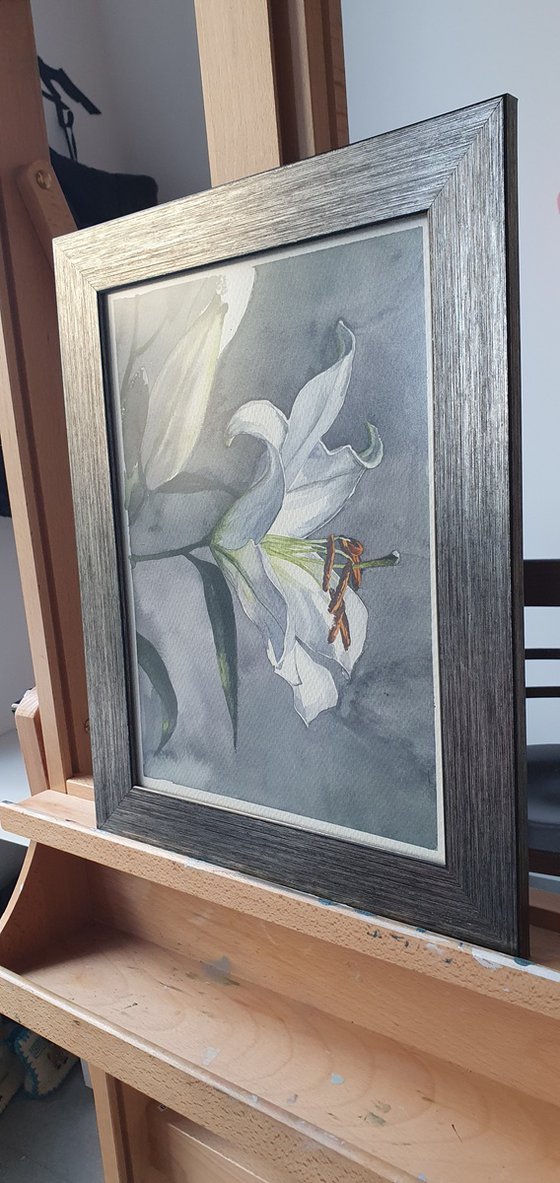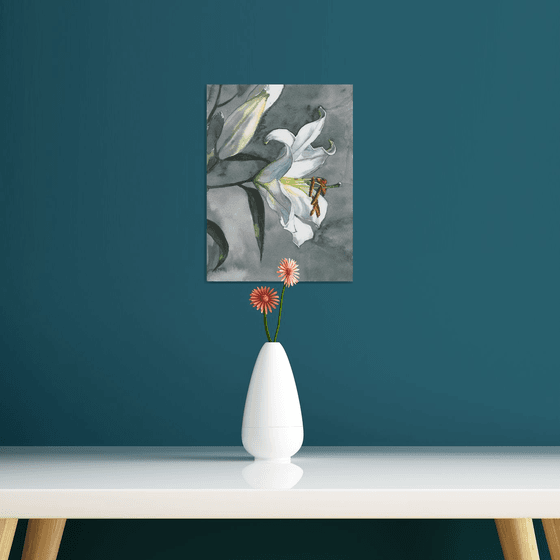Original artwork description:
The lily also holds symbolism of purity, innocence and fertility.
Additionally, the lily symbolizes vulnerability, and the freedom to be ourselves, as well as allowing others to be as they are too.
The lily is a symbolic flower of health and provision.
The white lily was likewise connoted with the fertility and eroticism of the Greek goddess Hera. In the Christian world, the lily was a symbol of purity, innocence and the virgin conception. It refers to the Virgin Mary and was therefore usually depicted in Annunciation scenes.
The lily also stands for light, hope and eternal life beyond death. At the same time, it symbolises the story of Christ's Passion. Thus, associations such as life, growth and fertility are inherent in the flower and were therefore connoted with ideas of femininity and sexuality. And what is the language of the flower in painting today? For this, we continue to trace the development of the flower motif.
After they had been depicted in antiquity and in the Middle Ages mostly as a symbol to underline a scene, flowers found their place in paintings as isolated objects in the late Renaissance. The so-called genre of floral still life developed.
Floral still lifes were particularly popular in the Netherlands, where flowers were considered a symbol of luxury in connection with the country's acquired wealth (Golden Age). Magnificent bouquets of flowers were arranged picturesquely, often in combinations that did not exist in reality, as the assembled flowers were in bloom at other times. Through this arbitrary arrangement of bouquets in painting, nature was conquered. The fact that these antipodes of «artificiality» and «nature» stand in opposition to each other is what distinguishes the flower motif: Something natural becomes artificial and, conversely, the artificial represents the natural.
−HAND-PAINTED: All paintings in the store are hand-painted. They are NOT computerized or poster prints.
-Material: professional quality Watercolor paper Aquarelle Canson, 100% cotton, cold press, 500 g/m2 + Winsor & Newton watercolors
- Painting is signed and dated by the artist as well as accompanied by a Certificate of Authenticity
-QUALITY: Created using top quality paints and materials giving you the best quality Watercolor paintings with textured, vibrant, and rich colors.
Materials used:
Watercolor
Tags:
#flowers #white #floral art #feminine #simple #plants and flowers #lily #mother's day #easterLILY (2021)
Watercolour
by Natasha Sokolnikova
4 Artist Reviews
Now £160.27 £213.7
25% off sale. Sale ends in 2 days 22 hours
- Watercolour on Paper
- One of a kind artwork
- Size: 40 x 40 x 2cm (framed) / 23 x 31cm (actual image size)
- Framed and ready to hang
- Signed on the back
- Style: Photorealistic
- Subject: Flowers and plants
Original artwork description
The lily also holds symbolism of purity, innocence and fertility.
Additionally, the lily symbolizes vulnerability, and the freedom to be ourselves, as well as allowing others to be as they are too.
The lily is a symbolic flower of health and provision.
The white lily was likewise connoted with the fertility and eroticism of the Greek goddess Hera. In the Christian world, the lily was a symbol of purity, innocence and the virgin conception. It refers to the Virgin Mary and was therefore usually depicted in Annunciation scenes.
The lily also stands for light, hope and eternal life beyond death. At the same time, it symbolises the story of Christ's Passion. Thus, associations such as life, growth and fertility are inherent in the flower and were therefore connoted with ideas of femininity and sexuality. And what is the language of the flower in painting today? For this, we continue to trace the development of the flower motif.
After they had been depicted in antiquity and in the Middle Ages mostly as a symbol to underline a scene, flowers found their place in paintings as isolated objects in the late Renaissance. The so-called genre of floral still life developed.
Floral still lifes were particularly popular in the Netherlands, where flowers were considered a symbol of luxury in connection with the country's acquired wealth (Golden Age). Magnificent bouquets of flowers were arranged picturesquely, often in combinations that did not exist in reality, as the assembled flowers were in bloom at other times. Through this arbitrary arrangement of bouquets in painting, nature was conquered. The fact that these antipodes of «artificiality» and «nature» stand in opposition to each other is what distinguishes the flower motif: Something natural becomes artificial and, conversely, the artificial represents the natural.
−HAND-PAINTED: All paintings in the store are hand-painted. They are NOT computerized or poster prints.
-Material: professional quality Watercolor paper Aquarelle Canson, 100% cotton, cold press, 500 g/m2 + Winsor & Newton watercolors
- Painting is signed and dated by the artist as well as accompanied by a Certificate of Authenticity
-QUALITY: Created using top quality paints and materials giving you the best quality Watercolor paintings with textured, vibrant, and rich colors.
Materials used:
Watercolor
Tags:
#flowers #white #floral art #feminine #simple #plants and flowers #lily #mother's day #easterReturns and refunds
We want you to love your art! If you are not completely satisfied with your purchase you can return it free within 14 days, no questions asked. Learn more
Artist Reviews (4)
This artwork is sold by Natasha Sokolnikova from Germany









